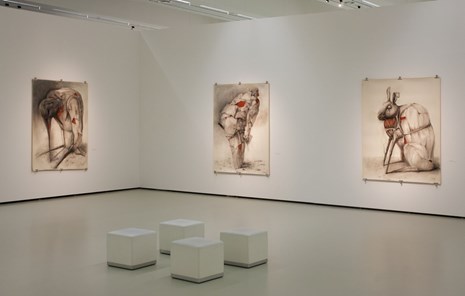Stasys Eidrigevičius

Stasys Eidrigevičius. A Face on the Mask
A face on a mask is one of the main recurring themes in the work of Stasys Eidrigevičius, which sheds a light on his idiosyncratic mindset and his view of the surrounding reality. Eidrigevičius rejects the traditional interpretation of the mask as an object that can conveniently be put on in order to become someone else, to become someone different. He is not interested in inanimate masks. He is concerned with the paradoxical meaning and purpose of a face on a mask: to breathe life into a lifeless being, to give a voice to something mute.
The theme of a face on a mask first surfaced in his work around 1986 in his pastel works. The subject of these pictures, who wears a mask with a face on it, at first sight resembles a puppet. His face appears emotionless and lifeless, the movements of his body are static and passive, the silhouette is highlighted by a simple "wooden" contour, while the structure of the body resembles an empty shell. The sad round eyes, like buttons, are one of the masked creature's most expressive features. Yet the pictures prompt us to ask why the artist chooses to portray puppet faces like masks. Why does he ignore real human faces? Do they say too little? The answers to these questions lie in the very origins of this concept of the character portrayed.
One of the sources for Eidrigevičius' work is the peasant culture of the countryside. It reveals itself not only in the symbolism of daily rural life, which he employs readily, choosing images such as a country road or a house in the country. The scale and the nature of the influence of this culture are best described by the metaphor of the peasant's hallucinatory powers, which was devised with reference to the work by the Belgian painter Constant Permeke. This power manifests itself as an irrational arrangement of elements of reality, strange associations, and dreamlike scenes that make the viewer feel uneasy.
What strikes us in Eidrigevičius' early work, the tempera miniatures up to the mid-1980s, is that odd time of day, that moment between day and night, when a gathering mist begins to obscure the horizon. Eidrigevičius immerses his characters in this mist, which covers them like a shroud or a mask. In some of the works, the mist acquires anthropomorphic shapes: dark eyeholes open up in it. Eidrigevičius has long been interested in things that cover voids or spaces, and which recur not only as mist, but also in more concrete forms, such as fences, nets, paper or clothes. The void concealed by a plane or a mask can be associated with states such as melancholy, nostalgia, or the ambiguous mood characteristic of nature. This void, however, penetrates the shell animating the mask, and imparts it with a certain psychological depth. The character created by the artist seems to have put on a mask because he was shaken by the world, by its poverty, its disasters, and so on; and yet he is all eyes as he looks at the world through the mask, which suddenly becomes alive. We can spot in the works a surprising and original insight: Eidrigevičius has, in a sense, found a parallel between his own concept of the mask and the culture of Japan. In order to perceive this parallel, we have to think of a Japanese woman's face, covered by a thin layer of paint, which appears stiff; and yet the vitality of the face still shows through the paint, in the form of wrinkles and the natural colouring of the facial skin. It is not surprising that the Japanese are very interested in Eidrigevičius' work. The concept of a face on a mask shows him as a storyteller and a visionary artist, observing and exploring the world, and this reveals a new aspect to his work. After all, he is seen primarily as an artist concerned with the fantastic, and as an illustrator.
He is famous in Lithuania and the world for his illustrations to children's books which several generations of children have grown up reading, and he is also a well-known and highly original poster artist. He sees visions, however, as a visionary storyteller. Thus, each of his works is a visual text: the masks tell stories, they whisper, wonder, and say their prayers.
Curators: Milda Žvirblytė, Regina Urbonienė


